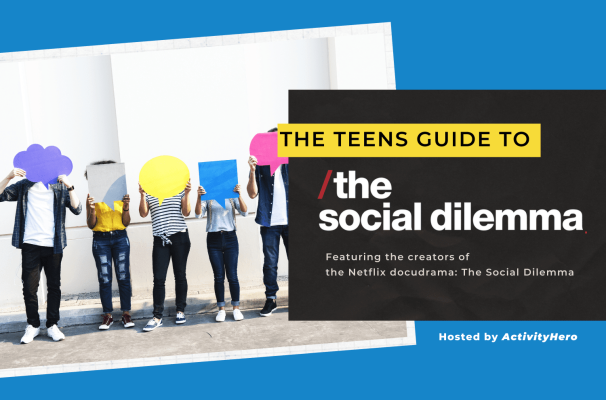Has social media been sneaking into your brain? Many teens are spending hours scrolling through perfectly filtered photos, obsessing over likes and shares, or encountering virtual bullies. Teens are going down a “rabbit hole” online, experiencing the tricks software developers use to keep people on Instagram, Snapchat, video games and other media.
How can we build healthier relationships with technology?Max Stossel, Head of Education for The Center for Humane Technology, illustrated some of the specific ways technology is designed to be addictive & distracting, provided tools to help combat these designs, and showcased a much needed discussion among peers about the impact of phones & social media on our lives during ActivityHero’s free event, The Teens Guide to the Social Dilemma.
Watch Max Stossel’s presentation available on-demand >>
Max’s Top tips for Social Media Well-being
- Turn off all notification except from people you care about
- Unfollow every account that makes you feel badly about yourself
- Delete toxic apps
- Use a physical alarm clock
- Get the phone out of the bedroom at least an hour before you go to sleep
- DF Youtube: an extension to make YouTube a more kid-friendly place (distraction-free, without suggested videos)
- Practice mindfulness to know yourself; what are you thinking and feeling?
- Give an 8-second hug a day!
#mysocialtruth
Share your stories on Socialtruth.humanetech.com
Q&A with Max Stossel
Transcribed from The Teens Guide to the Social Dilemma
Q1: What is the recommended time per day to spend on social media? How do we strengthen the emotional awareness of teens, should we slowly reduce screen-time or just stop?
There is no golden rule for the amount of time. I think it’s far more helpful to look at in terms of life. What role is social media serving for us? Is it entertainment? Are we aware of these mental health challenges? Are we doing other things? Are we doing the things we need to do with our lives? Some people do report saying “I have this one hour a day when I’m not going to just go on in a mindless moment. From 7 to 8 [o’clock], that’s going to be my social media time because I like social media.” Some people like doing it this way.
Especially for younger kids, these mental health challenges are real. To me, it’s just not worth the cost in the younger, middle school-age years. I don’t believe it’s worthwhile. And in terms of developing that emotional resilience, parents know better than me. I believe, especially in schools, looking into those curriculums and focusing on those topics is going to be practical. In this next generation, we’re going to need to know ourselves and our emotions to thrive in the digital world.
Q2: Is there an age where you think it’s ok for kids to be on social media?
I’m one person, with one person’s opinion, but I have spoken to a lot of parents. I have spoken to a lot of parents who have been very glad they have delayed. I have not spoken to parents who believe they wished they gave it earlier. For me, I would wait until at least high school. Our adult brains are hardly capable and it’s doing a number on our mental health.
It doesn’t mean don’t talk about it, or don’t have the conversations about it until high school if you’re on it, like sharing, and using it in your life. I could not build a better self comparison machine than social media.
To be honest, the idea that porn won’t seep in is not honest. People believe, it’s not my kid, but it’s a box with the entire internet on it. Everything that comes with the entire internet is involved with that box. We want the golden bullet – we want to have the good and not the bad. I think a more honest approach is recognizing this is really a lot and we haven’t as a society figured out good guard rails for ways of doing this thing yet. Let’s approach it honestly as a result.
Q3: Can you please discuss the YouTube rabbit hole and how does affect my brain?
YouTube is deciding with it’s algorithm, based on all your information, to figure out what’s the perfect piece of content that will get you watching. It doesn’t particularly care what is good for you, will make you smile, what will make you care, make you any of these things. What it cares about is you watching. Oftentimes that’s just like the most out-there extreme radical idea. And then we start believing what’s out there, not true things, and it messes with our sense making of the world. YouTube DF is a powerful tool so you can just turn off the recommended videos. So you can go to that one video that you meant to watch, and watch it, and then go about doing your best. And we might find now and then, as the slot machine, “I found something I really like!”, but if we turn off the recommendations we will be much happier.
Q4: I recently started my own YouTube channel, how does it affect me? I mostly post my own content.
I am an artist and a filmmaker; I use social media. I use it to promote. At your age, you can probably relate to this – you post something and then how does it feel? You are asking yourself “are people liking this?” “are people engaging with it?” I think one of the hardest things to do as someone creating content on YouTube, is to actually stick to doing to what you want to do. Not let “how many views did this get” drive what you’re making, everything you’re doing, because then you’re not really doing it because you want to do it.
We start [creating content] because I love XYZ and that’s why I’m going to make videos about it – I love it. But, then we start to get more into “this one I liked it, but it didn’t do as well, maybe I shouldn’t do it” like that and then the outside world starts to govern what you’re creating, what you’re making. And you start to care so much more about what everybody else thinks. That’s what to look out for. and it’s hard. It’s hard so get together with some friends and be like “hey we’re going to support each other”. Let’s make sure that we are actually doing this because we want to do it. If we [create content] for getting the likes then it becomes so addictive, literally addictive.
I have YouTube videos with millions of views and it’s endless. If you want to have one you want 5 and 10 there’s no number that is satisfying. It’s an endless treadmill. I want more more more more more and it never ends. So you can beat it by just posting what you actually want to post. Try and do what you actually want to share and not think about how good it does. Doing this is easier said than done.
Q5: What is the right age for kids to start gaming (i.e. Roblox)? Parent says “I’m very confused when my child says he plays for achievements.”
I mean I think that’s a similar example to what I was explaining with Halo. I just needed to get to the next level, I needed to accomplish it! Especially for young boys. Life is confusing for teenage boys and in Halo I know that “I do this one thing that is really hard, and then I get to the next level.” In life everything is scary and hard. Life doesn’t have an experience bar in that way.
What age is right? I think some games can be really educational. Games are obviously really really fun. My best advice would be – I would not compromise on the “just one more game because I’m going to lose.” The systems are designed so that you lose. When it’s dinner, it’s dinner like in the real world. Real world takes precedence over the video game world. And to recognize we are going to set limits because we know how easy it is to fall into the radicals of these games. Set and stick to those limits, make it an open conversation. Kids should have a voice in this. They should say what’s working and not working. It should be not a dictatorship, but a conversation.
Q6: How can you tell a teen is addicted to social? “My teen is says he’s not addicted to social, but he plays Discord and Roblox. I have noticed after he spends hours playing, his personality changes. He does not want to accept he is addicted.”
I am not a mental health counselor. There are many resources on our website that might be helpful. But your child has to be ready and willing and admitting that there’s a problem for any of this stuff to work. So having these conversations – talking about some of these resources, asking those questions, like “notice how it’s making you feel?” Also, they are probably afraid you’re going to take it away from them. This is a real problem that tends to exist.
Opening the conversation is the way to start. Some of these games are really disturbing because there aren’t actually enhancing something on a human level.
Are we learning something from it? Or is this just engaging? We have not approached this well as a society. Social media just happens to be a strong pull. It’s a journey. Hug your kids and tell them you love them. It’s not a solution but I have seen in my work it has been very helpful.
Q7: How can I monitor what they’re doing on their phone without infringing on their privacy ?
That question makes me laugh. Monitoring what they are doing on their phones, is infringing on their privacy. We want the best for them. This is a good example of creating trust and opening conversation.
You can try, you can put all of the monitoring software on there. But they will be able to get around all that software. Conversation can be one of the best. And for me, delay is the answer. Try to delay until high school to start introducing this stuff into lives. For me the mental health risks are not worth it.
Q8: Whenever I play video games and I am done, I always feel like there is nothing else to do and I feel bored. Then I want to play it again.
Try creating your own game, find new things. There are skills in life – video editing, photography, etc that you can choose to try rather than playing Fortnite. Find a replacement hobby, but have the expectation that nothing will hit you as hard as Fortnite.
Resource Links:
The Center for Humane Technology
Stayfosucd – site blocker for Chrome
Gamequitters.com/hobby-tool/
ActivityHero.com – find new educational or enrichment activities that build useful skills, like coding, video editing, web design, art, music, and more.

















